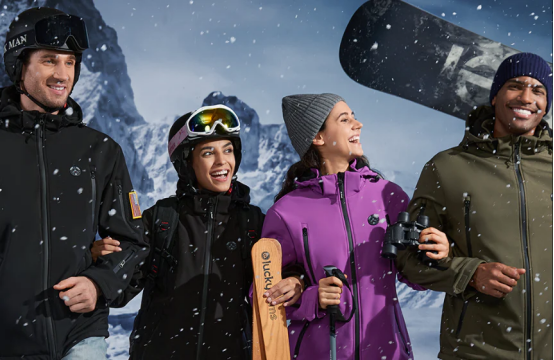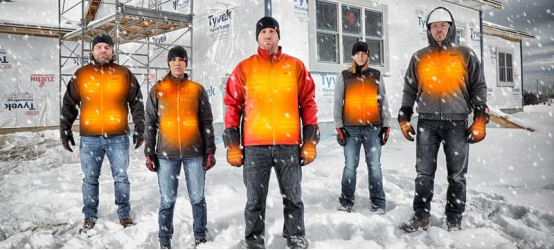Imagine stepping out into the chill of winter and feeling a cocoon of warmth envelop you, all thanks to the clothes you're wearing. This isn't a futuristic dream, as finding clothes to keep you warm in the market isn't a challenging task. However, heated clothes elevate this concept to a new level. Revolutionizing our experience in cold weather, these innovative garments blend technology with comfort, offering a personalized warmth that traditional layers can't match. In this article, we delve into the world of heated clothes, exploring how they transform our approach to outdoor activities, sports, and everyday life in colder climates. Prepare to discover how staying warm has become not just a necessity but a sophisticated, adjustable comfort.
What Are Heated Clothes?
Heated clothes are garments equipped with built-in heating elements that provide warmth to the body. These elements are powered by batteries, often rechargeable, making these clothes portable and convenient. The technology behind heated clothes is designed to offer warmth without bulk, enabling ease of movement and comfort.


How Do Heated Clothes Work?
The heating components found in these garments are usually constructed from slender and pliable materials such as carbon fiber or metal alloys. When activated, these components generate warmth, which is uniformly spread across crucial parts of the body. The majority of heated apparel includes customizable heat settings, enabling wearers to regulate the degree of coziness according to their surroundings and personal preferences.
Safety of Heated Clothes
Safety is a paramount concern with heated clothes. Reputable manufacturers, such as iHood, adhere to strict safety standards to ensure their products are safe for use. The heating elements are insulated and waterproofed to prevent any risk of electric shock. Moreover, many heated garments come with automatic shut-off features to prevent overheating.
iHood’s Heated Clothes to Keep You Warm
- iHood’s Heated Jackets
- Characteristics: iHood’s heated jackets come equipped with built-in heating elements strategically placed in the chest, back, and other key areas, ensuring effective heat distribution. They boast adjustable temperature settings, allowing wearers to fine-tune the warmth to their liking. These jackets are meticulously designed to endure diverse outdoor conditions, providing both weather resistance and long-lasting durability.
- Best Uses: Ideal for outdoor enthusiasts, winter sports, daily commuting in cold climates, and activities where overall body warmth is essential.


- iHood’s Heated Vests
- Features vs. Jackets: While similar to heated jackets, iHood’s heated vests focus on warming the core while leaving arms free, offering greater mobility. They also have heating elements in the front and back and are designed for layering or standalone use.
- Ideal Scenarios for Use: Perfect for activities that require arm mobility, such as hiking, biking, or outdoor work. They are also great for layering under heavier coats in extreme colds.
- Comparison with Jackets: Vests provide core warmth with less bulk and more flexibility compared to jackets, making them a versatile option in milder cold conditions.


- iHood’s Heated Gloves
- Importance for Extremity Warmth: iHood’s heated gloves are crucial for keeping hands warm, preventing conditions like frostbite in extreme cold. They are especially important for outdoor activities where dexterity and hand comfort are vital.
- Technology Specifics: These gloves feature heating elements along the fingers and back of the hand. Advanced models offer adjustable heat settings and are made with materials that balance insulation with dexterity.
- Ideal Uses: Essential for winter sports, biking, hiking, and any outdoor activity in cold weather where hand warmth and mobility are crucial.
- iHood’s Heated Socks
- Advantages for Outdoor Pursuits: iHood’s heated socks offer precise warmth to the feet, addressing a common source of discomfort in chilly environments. They prove indispensable for endeavors requiring extended exposure to frigid terrain or snow.
- Characteristics: iHood's heated socks incorporate heating components strategically positioned around the toes and the lower portion of the foot. They prioritize comfort, breathability, and frequently possess moisture-wicking properties to ensure feet remain both warm and dry.
- Ideal Scenarios: Heated socks prove exceptionally beneficial for pursuits such as skiing, snowboarding, cold-weather hiking, and for individuals involved in outdoor occupations amidst freezing conditions.
Renowned for their excellence and technological innovations, iHood provides a diverse selection of heated clothing choices to cater to a wide range of requirements and personal tastes.
Choosing the Right Heated Clothes
Choosing the ideal clothes to keep you warm in cold weathers entails more than merely selecting a style; it involves discovering the ideal combination of comfort, functionality, and durability. Here are essential factors and guidance to assist you in making a well-informed decision:


Factors to Consider
- Battery Life: This is crucial, as it determines how long you can enjoy the warmth. Look for clothes with long-lasting batteries, and consider the ease of recharging. Some advanced models offer USB charging, which adds convenience.
- Material: The material of heated clothes not only affects comfort but also the efficiency of heat distribution and durability. Opt for materials that balance insulation with breathability, and check for water and wind resistance for outdoor use.
- Heat Settings: Adjustable heat settings are essential for regulating temperature according to your environment and preference. More settings mean more flexibility in different weather conditions.
- Durability: Since heated clothes incorporate technology, their durability is vital. Check for warranties and customer reviews to gauge the longevity of the product.
Guide to Sizing and Fit
The fit of your heated clothes is key to comfort and effective heat distribution. Too tight, and you might restrict movement or the efficiency of heating elements; too loose, and you lose the benefit of targeted warmth. Always refer to the sizing guide of the specific brand, and consider how you'll layer your clothes underneath.
Maintenance Tips
To extend the life of your heated clothes, follow the care instructions provided by the manufacturer. This often includes guidance on washing, drying, and storing your garments. Avoid harsh chemicals and excessive wringing or twisting, which can damage the heating elements. Regularly check the battery and connections for signs of wear and tear, and store your clothes in a dry, cool place when not in use.
By considering these factors and following the maintenance tips, you can ensure that your investment in heated clothes brings you lasting warmth and comfort.
Heated Clothes in Action
Heated clothes are not just a technological novelty; they're practical solutions for various real-life scenarios. Here are five use cases that showcase the effectiveness of heated clothes to keep you warm:
- Winter Sports Enthusiasts: Skiers and snowboarders can particularly benefit from heated jackets and gloves. These garments provide consistent warmth, enhancing endurance and performance in cold, snowy conditions. The adjustable heat settings allow temperature regulation as activity levels change throughout the day.
- Outdoor Work: For those working outdoors in winter, such as construction workers or photographers, heated vests and socks are a boon. They provide sustained warmth without the bulk of heavy layers, ensuring mobility and comfort during long hours outside. This not only improves work efficiency but also safeguards against cold-related health risks.
- Commuting in Cold Climates: For daily commuters in cities with harsh winters, a heated jacket can transform the experience of walking or waiting for public transport. The convenience of battery-powered warmth means you can step out of your home and immediately feel the cozy embrace, making your commute more pleasant.
- Hiking and Camping: Heated clothes are invaluable for hikers and campers facing chilly nights or cold mornings. Heated vests and socks keep the core and feet warm, critical areas that can significantly affect overall body temperature. This added warmth can make camping more comfortable and safe, even in unpredictable weather.
- Health and Comfort for the Elderly: Elderly individuals, especially those with health conditions like arthritis, find great comfort in heated garments. Heated gloves and socks can provide gentle, therapeutic warmth, helping to alleviate joint pain and stiffness associated with cold weather. This not only offers physical relief but also enhances their ability to engage in daily activities during colder months.
Each of these scenarios illustrates the versatility and practicality of heated clothes. Whether it's for sports, work, daily life, or health reasons, these garments provide a customizable, efficient way to stay warm, underlining their growing popularity and necessity in cold climates.


The Future of Heated Clothes
- The future of heated clothes is poised at an exciting intersection of technology and sustainability. As we look ahead, emerging technologies are set to enhance the functionality and efficiency of these garments. Innovations like ultra-thin heating elements and smarter, energy-efficient batteries will make heated clothes lighter and more versatile, while IoT integration promises personalized temperature control through smart devices.
- Environmental impact and sustainability are also becoming pivotal in the development of heated clothes. Future designs are expected to incorporate eco-friendly materials and renewable energy sources, reducing the carbon footprint associated with production and use. Solar-powered heating systems and biodegradable fabrics are just a couple of the sustainable approaches being explored.
- Predictions for heated clothes include advancements in self-regulating temperature control, where garments automatically adjust the heat based on external temperatures and body heat. The integration of health-monitoring sensors could also provide added value, making heated clothes not just a source of warmth but also a tool for health and well-being.
These advancements promise to make heated clothes more accessible, efficient, and environmentally friendly, solidifying their place as essential gear for anyone facing the cold.
Conclusion
In conclusion, heated clothes, particularly those offered by brands like iHood, stand as a testament to the incredible advancements in wearable technology. They offer an unparalleled combination of warmth, convenience, and adaptability, revolutionizing how we confront cold weather. From the bustling streets of a winter city to the serene silence of a snowy mountain trail, heated clothes provide customizable comfort and enduring warmth. So if you are looking for clothes to keep you warm in extreme cold months, iHood's heated products must be your best choice. We encourage you to consider the innovative solutions that heated clothes, especially those from iHood, provide as you seek comfort and warmth in your cold-weather endeavors.




